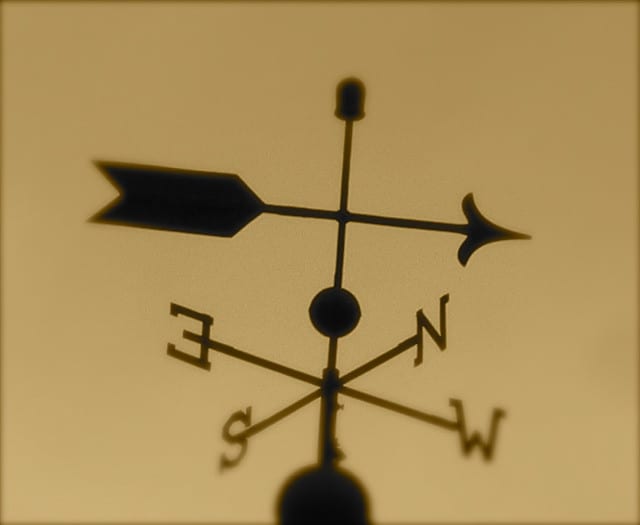
Heading in a NonDirective Direction
Some of us grow up believing in the importance of being directive.
People tell us life is all about making progress in a particular direction. The sooner we know where we are going and how we plan to get there, the better. Finding our direction is a significant part of growing up, maturing, and getting on with life.
It is almost like life is a race and we need to build up some speed in the right direction.
Many of us inherit our direction from our families or find it in books we read. Some of us find it like a bolt of lighting while others discover it in a long, difficult process.
The one thing I remember anyone asking me when I was a child was what I wanted to be. I decided I wanted to become a lawyer when I was in third grade, before I knew much about what it was like.
Having chosen my direction, my focus grew from third grade until I finished law school.
It was as if the direction I had chosen had also chosen me. It drew me forward, step by step.
I believed that was how life worked. We chose a direction and then set out to overcome any obstacles.
That was how I experienced spiritual life as well. Choosing the right direction was crucial to how spiritual life worked. We set out in a particular direction and dealt with the challenges which crossed our paths.
I worked hard to make progress in the directions I had chosen. When things got in the way it was my responsibility to move them out of the way, to get past them.
It was hard work and it took a lot of struggle.
I began to wonder about the idea of a nondirective direction.
A More NonDirective Direction
I believed strongly in the directions I had chosen. It was not clear to me there were any other directions I could have chosen or any changes I could make. I did not see I had any other options and felt I was trapped.
The thing which persuaded me I needed some new directions was how miserable I was.
It did not matter whether the directions I had chosen were right or wrong. I realized I could not continue going in the direction I had been going.
The most supportive and helpful thing people did for me was not telling me what to do. There were people who were concerned about me and my search for new directions. They listened to me talk and asked me great questions.
It was important for me to find new directions on my own. I did not need anyone to fix me or set me straight.
Not only did I need to find new directions, I needed to become less directive.
It took me some time to realize I was headed in a new direction. There was tremendous relief in not obsessing about where I was headed every minute of the day.
Life is not about having all the answers and sharing them with other people. I gradually started to appreciate asking questions more than answering them.
Each of us can use some help sorting out where we are headed. It is not a matter of writing the perfect checklist or finding the perfect direction.
We do not need anyone to tell us which direction to take. It is about finding someone who can help us understand the directions we are choosing.
Other people can help us discover and explore a more nondirective direction.
How Does NonDirective Direction Work?
It is important to know where we want to go, and to be aware enough to make changes. We want to know what we believe while being open to new possibilities.
Knowing our direction in life does not mean we have a responsibility to be directive toward others. Choosing a direction does not lock us into specific goals or practices. There is always something we can learn from other people with other approaches.
Spending time at the hermitage where I am a lay Oblate is an example of nondirective direction. The stillness of the community’s everyday rhythms helps people remain open to others. Monks are not trying to convince their guests about theological questions. Each person is given opportunities to explore their own openness.
Members of the community are available to listen and make suggestions, but it is not required. Each person is welcome.
Direction matters. Where we want to go makes a difference. Nondirective direction is a balance between choosing a direction and taking time to listen and pay attention to each moment.
We have an idea of where we want to go and the flexibility to change directions. Each day is filled with new possibilities.
Taking Steps in a NonDirective Direction
Moving in a nondirective direction was a last resort for me. I could not continue in the direction I has chosen. Different directions had chosen me and I needed to take time to discover them.
I learned to significance of not having everything decided. It was important to me to be organized, to set overcome obstacles and make progress. I began to reflect on where those obstacles were coming from.
Life is more than an exercise of our will to keep moving. We learn to listen to what gets in our way and be open to the lessons it is trying to teach us. Finding the meaning in our obstacles is a step toward heading in a nondirective direction.
Many of us will need other people to help us. We do not need people to tell us what to do or where to go. Our help comes from people who listen without giving us answers.
We will find our nondirective directions on our own.
Exploring our nondirective direction shows us how to listen, even to ourselves.
How will we take steps in a nondirective direction today?
Where will a more nondirective direction help us go this week?
[Image by 23am.com]
Greg Richardson is a spiritual life mentor and coach in Southern California. He is a recovering attorney and a lay Oblate with New Camaldoli Hermitage near Big Sur, California. Greg’s website is StrategicMonk.com and his email address is [email protected].












